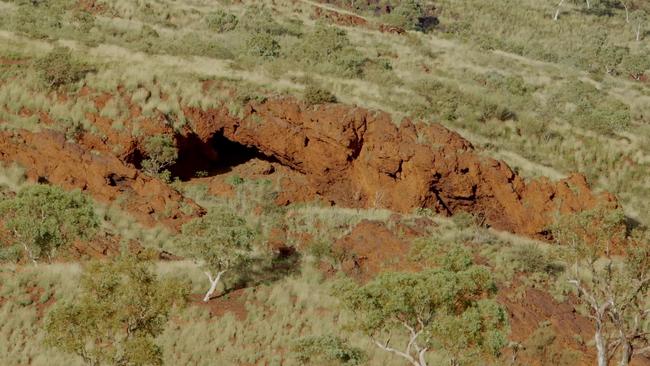Rio Tinto film exposes miner on Juukan Caves loss
A documentary shows that Rio Tinto knew how deeply indigenous peoples felt about the ancient caves that the mining company destroyed.

“I spent the last five years here walking around and as I was walking, they blown it up behind me,” said Harold Ashburton in 2015, standing in a spot not far from Juukan Caves which were also detonated into oblivion by Rio Tinto’s Brockman iron ore mine last month.
“They shouldn’t have been up here blasting on this area because of what was here,” says Ashburton, whose grandfather was born in one of the doomed Pilbara caves, 60km east of Tom Price, where people lived as far back as 46,000 years ago.
If ever there was any doubt that Rio Tinto knew how deeply Ashburton’s Puutu Kunti Kurrama and Pinikura peoples felt about the ancient caves that the mining company destroyed legally with WA government heritage exemptions, that doubt is dispelled by a film paid for by the company itself.
The film was Ngurra Minarli, a documentary made in the ore-red, white-trunked eucalypt country of Rio’s Brockman mine in 2015, to allow elders to document their country.
The PKKP has released the film exclusively to The Australian to show that Rio Tinto was wrong to state last week that it didn’t know the traditional owners were desperate to save their significant sites. After the news of the caves’ destruction around May 23 caused a national outcry, Rio Tinto iron ore chief executive Chris Salisbury said “we are sorry that the recently expressed concerns of the PKKP did not arise through the engagements that have taken place over many years”.
But every film utterance by elders contradicts that view, as they plea for understanding of their country’s plants, animals and ancestors’ tracks through the Juukan Valley and the Puutukunti site where excavation revealed the extreme dates, twice as old as France’s Lascaux Caves.
Ashburton opens the film saying: “We want to tell you and show you this place (and) why it is important to us.” Sandra Hayes describes how “all sites are important to us, every site we find.” But she adds later: “Even though in our heart we try to save all the sites around the area, we never win.”
Another woman explains that the Juukan cave floor — now destroyed — was excavated to 1.7 metres “and we found thousands of stone artefacts, animal bones fragments and echidna spines, emu eggshells, seeds, grasses and animal droppings.”
Ashburton expresses his anger that “showing the people that (cave), doing the arch (eology) work today is like exposing the country for them to open it up, blow it up, giving them access”. “What’s left of our country because of mining far and wide?,” he says, looking over the eucalypt and rich iron ore-red country. He says he brought his two sons out to see where his grandfather was born in the now-mined Brockman area. “They turned around and said ‘it’s f..ked’.
“All you can do is keep a picture in your head, what you seen, how it was.”
The PKKP says it is seeking a full description of the damage from last month’s detonations. A Rio Tinto spokesman told The Australian on Tuesday that the company would not comment on “the state of the area”.



To join the conversation, please log in. Don't have an account? Register
Join the conversation, you are commenting as Logout